Socioeconomic Profile of Agricultural Producers and Production Systems in Municipalities of Piauí, Brazil
Abstract
1. Introduction
2. Materials and Methods
2.1. Study Area
2.2. Data Collection
2.3. Data Analysis
2.4. Ethical and Legal Aspects
3. Results
3.1. Socioeconomic Profile of the Communities
3.2. Length of Residence
3.3. Monthly Income of the Interviewees
3.4. Property Size
4. Discussion
4.1. Education of the Interviewees from the Three Studied Municipalities
4.2. Demographic Data
4.3. Sources of Income: Agriculture, Commerce, and Handicrafts
4.4. What They Plant/Reason for Planting
4.5. Age by Gender of the Interviewees
4.6. Length of Residence in Communities
4.7. Income of the Interviewees
4.8. Property Size
5. Conclusions
Author Contributions
Funding
Institutional Review Board Statement
Informed Consent Statement
Data Availability Statement
Conflicts of Interest
References
- Kureski, R.; Moreira, V.R.; da Veiga, C.P. Agribusiness Participation in the Economic Structure of a Brazilian Region: Analysis of GDP and Indirect Taxes. Rev. Econ. E Sociol. Rural. 2020, 58, 1–11. [Google Scholar] [CrossRef]
- Pereira, C. Analysis of the Use of Technological Inputs in Northeastern Agriculture. Raízes Rev. Ciências Sociais Econômicas 2020, 40, 325–346. [Google Scholar] [CrossRef]
- Instituto Brasileiro de Geografia e Estatística. Estimativa populacional [Internet]. Rio de Janeiro: Instituto Brasileiro de Geografia e Estatística. 2020. Available online: https://sidra.ibge.gov.br/pesquisa/estimapop/tabelas (accessed on 8 February 2025).
- Lavall, T.P.; Olsson, G. Governança global e o desenvolvimento na sua pluridimensionalidade: Um olhar sobre a Agenda 2030 das Nações Unidas. Direito Desenvolv 2019, 10, 51–64. [Google Scholar] [CrossRef]
- Belik, W. A política brasileira de segurança alimentar e nutricional: Concepção e resultados. Rev. Segurança Aliment. Nutr. 2012, 19, 94–110. [Google Scholar] [CrossRef]
- Antonino, A.C.D.; Hammecker, C.; Montenegro, S.M.L.G.; Netto, A.M.; Angulo-Jaramillo, R.; Lira, C.A.B.O. Subirrigation of Land Bordering Small Reservoirs in the Semi-Arid Region in the Northeast of Brazil: Monitoring and Water Balance. Agric. Water Manag. 2005, 73, 131–147. [Google Scholar] [CrossRef]
- Assiri, M.; Barone, V.; Silvestri, F.; Tassinari, M. Planning Sustainable Development of Local Productive Systems: A Meth-odological Approach for the Analytical Identification of Ecoregions. J. Clean. Prod. 2021, 287, 125006. [Google Scholar] [CrossRef]
- Saath, K.C.O.; Fachinello, A.L. Crescimento da demanda mundial de alimentos e restrições do fator terra no Brasil. Rev. Econ. Sociol. Rural 2018, 56, 195–212. [Google Scholar] [CrossRef]
- Khan, N.; Ray, R.L.; Sargani, G.R.; Ihtisham, M.; Khayyam, M.; Ismail, S. Current progress and future prospects of agriculture technology: Gateway to sustainable agriculture. Sustainability 2021, 13, 4883. [Google Scholar] [CrossRef]
- Takahashi, K.; Muraoka, R.; Otsuka, K. Technology adoption, impact, and extension in developing countries’ agriculture: A review of the recent literature. Agric. Econ. 2020, 51, 31–45. [Google Scholar] [CrossRef]
- Bhat, S.A.; Huang, N.-F.; Sofi, I.B.; Sultan, M. Gestão da Cadeia de Suprimentos Agrícola e Alimentar Baseada em Blockchain e IoT: Uma Narrativa sobre a Interoperabilidade de Blockchain Empresarial. Agricultura 2022, 12, 40. [Google Scholar]
- Firmino, R.G.; Fonseca, M.B. Uma Discussão Sobre os Impactos Ambientais Causados Pela Expansão da Agricultura: A Produção de Biocombustíveis no Brasil. Univ. Fed. Paraíba 2010, 38, 206–214. [Google Scholar]
- Silva, A.J.; Monteiro, M.S.L.; e Barbosa, E.L. From modernization to de territorialization:dynamics and dilemmas of agricultural work in the Cerrado of Piauí, Brazil. Redes 2020, 25, 744–761. [Google Scholar] [CrossRef]
- Aguiar, T.d.J.A.; Monteiro, M.d.S.L. Agricultura moderna e desenvolvimento sustentável no Cerrado piauiense. Cerrado Piauiense Ambient. Soc. 2005, 8, 161–178. [Google Scholar] [CrossRef]
- Instituto Brasileiro de Geografia e Estatística. Manual Técnico de uso da Terra. Coordenação dos Recursos Natu-rais e Estudos Ambientais, 3rd ed.; Instituto Brasileiro de Geografia e Estatística: Rio de Janeiro, Brasil, 2013. [Google Scholar]
- Bernard, H.R. Research Methods in Anthropology: Qualitative and Quantitative Approaches; Rowman & Littlefield Publishers: Lanham, MD, USA, 2006. [Google Scholar]
- da Silva, G.S.; Amarante, P.A.; Amarante, J.C.A. Agricultural Clusters and Poverty in Municipalities in the Northeast Region of Brazil: A Spatial Perspective. J. Rural. Stud. 2022, 92, 189–205. [Google Scholar] [CrossRef]
- Potrich, R.; Grzybovski, D.; Toebe, C.S. Sustentabilidade nas pequenas proprie-dades rurais: Um estudo exploratório sobre a percepção do agricultor. Estud. Soc. Agric. 2017, 25, 208–228. [Google Scholar]
- Soares, L.A. Amarante: Personalidades e Fatos Marcantes; Gráfica Ipanema: Teresina, Brazil, 2011; 513p. [Google Scholar]
- de Medeiros, C.N.; de Souza, M.J.N.; Gomes, D.D.M.; Albuquer-Que, E.L.S. Caracterização socioambiental do município de Caucaia (CE) utilizando sistema de in-formação geográfica (SIG): Subsídios para o ordenamento territorial. Geogr. Ensino Pesqui. 2012, 16, 163–181. [Google Scholar]
- Lira Filho, M.A.S. Análise Geoecológica da Bacia Hidrográfica do Rio Mulato; Trabalho de Conclusão de Curso; Universidade Federal do Piauí: Teresina, Brazil, 2011; 83p. [Google Scholar]
- Minas, C. Amarante um Lugar Cheio de Poesia e Cultura Localizado no Estado do Piauí. 2017. Available online: https://amarante.pi.gov.br/amarante/informacoesgerais/municipio/?tipo=turismo (accessed on 8 February 2025).
- Aguiar, R.B.; Gomes, J.R.C. Projeto Cadastro de Fontes de Abastecimento Por Água Subterrânea, Estado Do Piauí: Diag-nóstico Do Município de Amarante. 2004; pp. 1–21. Available online: https://rigeo.sgb.gov.br/jspui/bitstream/doc/15755/2/Rel_Amarante.pdf (accessed on 8 February 2025).
- Correia-Lima, F.G.; de Figueiredo, P.Z.; Nunes, J.N.P. Prevalência Da Infecção Chagásica Na População Humana Determinada Pelo Teste de Imunofluorescência Indireta Em 24 Municípios Do Estado Do Piauí. Rev. Soc. Bras. Med. Trop. 1976, 10, 17–25. [Google Scholar] [CrossRef]
- Cepro O Índice de Vulnerabilidade Social No Piauí Por Territórios de Desenvolvimento. 2018; p. 51. Available online: http://www.cepro.pi.gov.br/download/201802/CEPRO08_365efb6de8.pdf (accessed on 8 February 2025).
- Amorim, K.P.C. Ética Em Pesquisa No Sistema CEP-CONEP Brasileiro: Reflexões Necessárias. Cien. Saude Colet. 2019, 24, 1033–1040. [Google Scholar] [CrossRef]
- Albuquerque, U.P.; Lucena, R.F.P.; Cunha, L. Métodos e Técnicas Na Pesquisa Etnobiológica e Etnoecológica; Nupeea Recife: São Paulo, Brazil, 2010; Volume 27, pp. 336–346. [Google Scholar]
- da Silva, A.J.; Monteiro, M.d.S.L.; Barbosa, E.L. Agricultura Familiar: Perspectiva de um debate que não esgota. Rev. Campo-Territ. 2016, 11, 24. [Google Scholar] [CrossRef]
- Oliveira, R.P.; Aquino, J.R. Social security and its importance for rural families poor in Northeast Region: Results of a case study in Rio Grande do Norte. Rev. Econômica Nordeste 2017, 48, 115–130. [Google Scholar] [CrossRef]
- Mosquem, M.H.R.; Beal, Z.; Agostini, A.D. Educação do Campo: Educação que promove a dignidade do povo campe-sino. In Experiências e Reflexões Sobre Escolas/Classes Multisseriadas, 1st ed.; In-sular Livros: Florianópolis, Brazil, 2014; Volume 1, pp. 1–296. [Google Scholar]
- Souza, K.P.Q.; Ertzogue, M.H.; Zwierewicz, M. Ecoformação: Entre dilemas e desafios, um olhar transformador para o sé-culo XXI. Rev. Humanidades Inovação 2020, 7, 119–128. [Google Scholar]
- Gohn, M.G. Educação não formal: Direitos e aprendizagens dos cidadãos (âs) em tempos do coronavírus. Rev. Humanidades Inovação 2020, 7, 9–20. [Google Scholar]
- Guo, Y.; Wang, J. Spatiotemporal changes of chemical fertilizer application and its environmental risks in China from 2000 to 2019. Int. J. Environ. Res. Public Health 2021, 18, 11911. [Google Scholar] [CrossRef] [PubMed]
- Alengebawy, A.; Abdelkhalek, S.T.; Qureshi, S.R.; Wang, M.-Q. Heavy metals and pesticides toxicity in agricultural soil and plants: Ecological risks and human health implications. Toxics 2021, 9, 42. [Google Scholar] [CrossRef]
- Yang, T.; Siddique, K.H.; Liu, K. Cropping systems in agriculture and their impact on soil health—A review. Glob. Ecol. Conserv. 2020, 23, e01118. [Google Scholar] [CrossRef]
- Noce, M.A.; Ferreira Neto, J.A. Uma análise de política pública brasileira de desenvolvimento rural, com foco no combate à pobreza no campo. Cad. Ciências Sociais UFRPE 2016, 1, 36–56. [Google Scholar]
- Barbosa, E.B.; Batista, J.J.R.; Pimenta, H.F.S. Agricultura familiar: Características, importância, pluriatividade, mul-tifuncionalidade e perspectivas dentro e fora da Amazônia. Obs. Econ. Latinoam. 2024, 193, 15. [Google Scholar]
- Oler, J.R.L.; Amorozo, M.C.M. Etnobotânica e conservação on farm de mandioca (Manihot esculenta Crantz) na agricultura de pequena escala no Estado de Mato Grosso. Interações 2017, 18, 137–153. [Google Scholar] [CrossRef]
- Dalmoro, M.; Medeiros, L.; Pauli, J.; Amarante, M.V. La lógica de productores invisibles: Significado cultural en la familia de producción agrícola. Rev. Eletrônica Adm. 2017, 23, 92–115. [Google Scholar] [CrossRef]
- Grisa, C.; Kato, K.; Zimmermann, S.A. O rural nas políticas públicas do Brasil contemporâneo. In Tipo-Logia Regionalizada dos Espaços Rurais Brasileiros: Implicações no Marco Jurídico e Nas Políticas Públicas; Miranda, C., Ed.; IICA: Brasília, Brazil, 2017; pp. 337–481. [Google Scholar]
- Esteban, M.T. Olhares e Interfaces: Reflexões Críticas Sobre a Avaliação; Cortez: São Paulo, Brazil, 2010. [Google Scholar]
- Matte, A.; Spanevello, R.M.; Lago, A.; Andreatta, T. Agricultura e Pecuária Familiar: (des) continuidade na repro-dução social e na gestão dos negócios. Rev. Bras. Gestão Desenvolv. Reg. 2019, 15, 19–33. [Google Scholar]
- Lago, A. Analyzing Decision-Making Factors in the Generational Succession of Rural Youth. J. Co-oper. Organ. Manag. 2022, 10, 100187. [Google Scholar] [CrossRef]
- Rocha, H.S.; Ribeiro, K.V.; Albuquerque, E.L.S. Geodiversidade do município de amarante, estado do piauí. Geosaberes 2018, 18, 1–10. [Google Scholar] [CrossRef]
- Losada, H.T.; Martínez, H.; Vieyra, J.; Pealing, R.; Rivera, J.; Zavala, R.; Cortés, J. Urban Agriculture in the Metropolitan Zone of Mexico City: Changes over Time in Urban, Suburban and Peri-Urban Areas. Earthscan Read. Rural Link. 2018, 247–264. [Google Scholar] [CrossRef]
- McCampbell, M.; Schumann, C.; Klerkx, L. Good Intentions in Complex Realities: Challenges for Designing Responsi-bly in Digital Agriculture in Low-Income Countries. Sociol. Rural. 2022, 62, 279–304. [Google Scholar] [CrossRef]
- Silva, M.G. Between bonds and vehicles: Rural woman representation from the appropriation of the TICs. Rev. Mídia Cotidiano 2017, 11, 98–119. [Google Scholar] [CrossRef]
- Abreu, T.L. O Programa Nacional de Fortalecimento da Agricultura Familiar no estado da Paraíba: Avanços e desafios. Rev. Principia 2017, 35, 125–138. [Google Scholar] [CrossRef]
- Barbosa, R.A.; Domingues, C.H.d.F.; dá Silva, M.C.; Foguesatto, C.R.; Pereira, M.d.A.; Gimenes, R.M.T.; e Borges, J.A.R. Using Q-methodology to identify rural women’s viewpoint on succession of family farms. Land Use Policy 2020, 92, 104489. [Google Scholar] [CrossRef]
- Zhang, W.E.; Katob, P.; Bhandaryb, E.; Nkonyab, H.I.; Ibrahimc, M.; Agbonlahord, H.Y.; Ibrahimc, H.; Cox, C. Awareness and perceptions of ecosystem services in relation to land use types: Evidence from rural communities in Nigeria. Ecosyst. Serv. 2016, 22, 150–160. [Google Scholar] [CrossRef]
- Page, G.; Bellotti, B. Farmers value on-farm ecosystem services as important, but what are the impediments to participation in PES schemes? Sci. Total Environ. 2025, 515–516, 12–19. [Google Scholar] [CrossRef]
- Moreira, S.d.L.; Spanevello, R.M. Modelos sucessórios em propriedades rurais: Um estudo no município de Cruz Alta/RS. Rev. Grifos 2019, 28, 27–47. [Google Scholar] [CrossRef]
- Pochmann, M. Estado e capitalismo no Brasil: A inflexão atual no padrão das políticas públicas do ciclo político da nova república. Educ. Soc. 2017, 38, 309–330. [Google Scholar] [CrossRef]
- Ioris, A.R. Rent of agribusiness in the Amazon: A case study from Mato Grosso. Land Use Policy 2016, 59, 456–466. [Google Scholar] [CrossRef]
- Ney, M.G.; Hoffmann, R. Desigualdade de renda na agricultura: O efeito da posse da terra. Economia 2003, 4, 113–152. [Google Scholar]
- Vinholis, M.M.B.; Carrer, M.J.; Souza Filho, H.M. Adoption of beef cattle traceability at farm level in São Paulo State, Brazil. Ciência Rural 2017, 47, 1–7. [Google Scholar] [CrossRef]
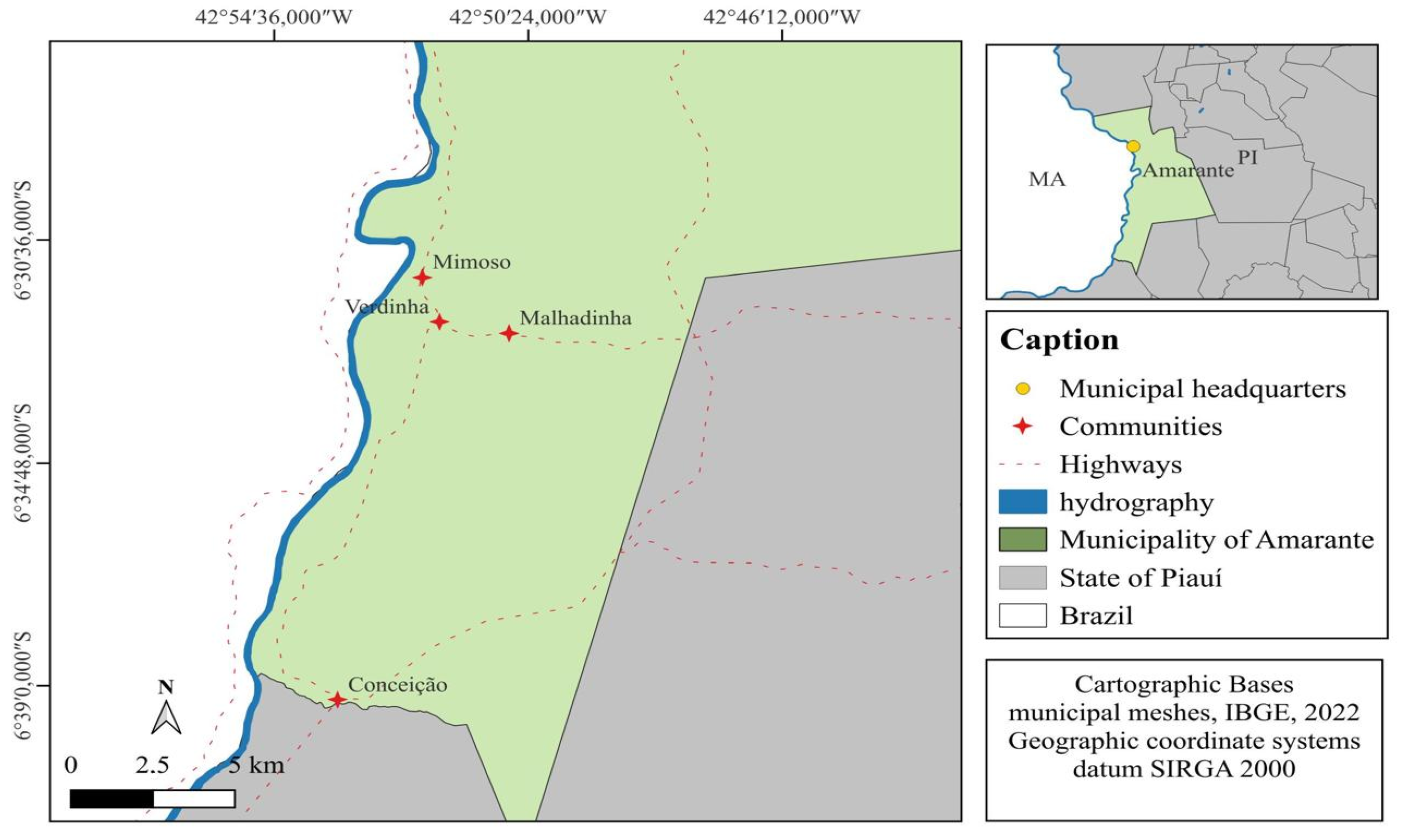
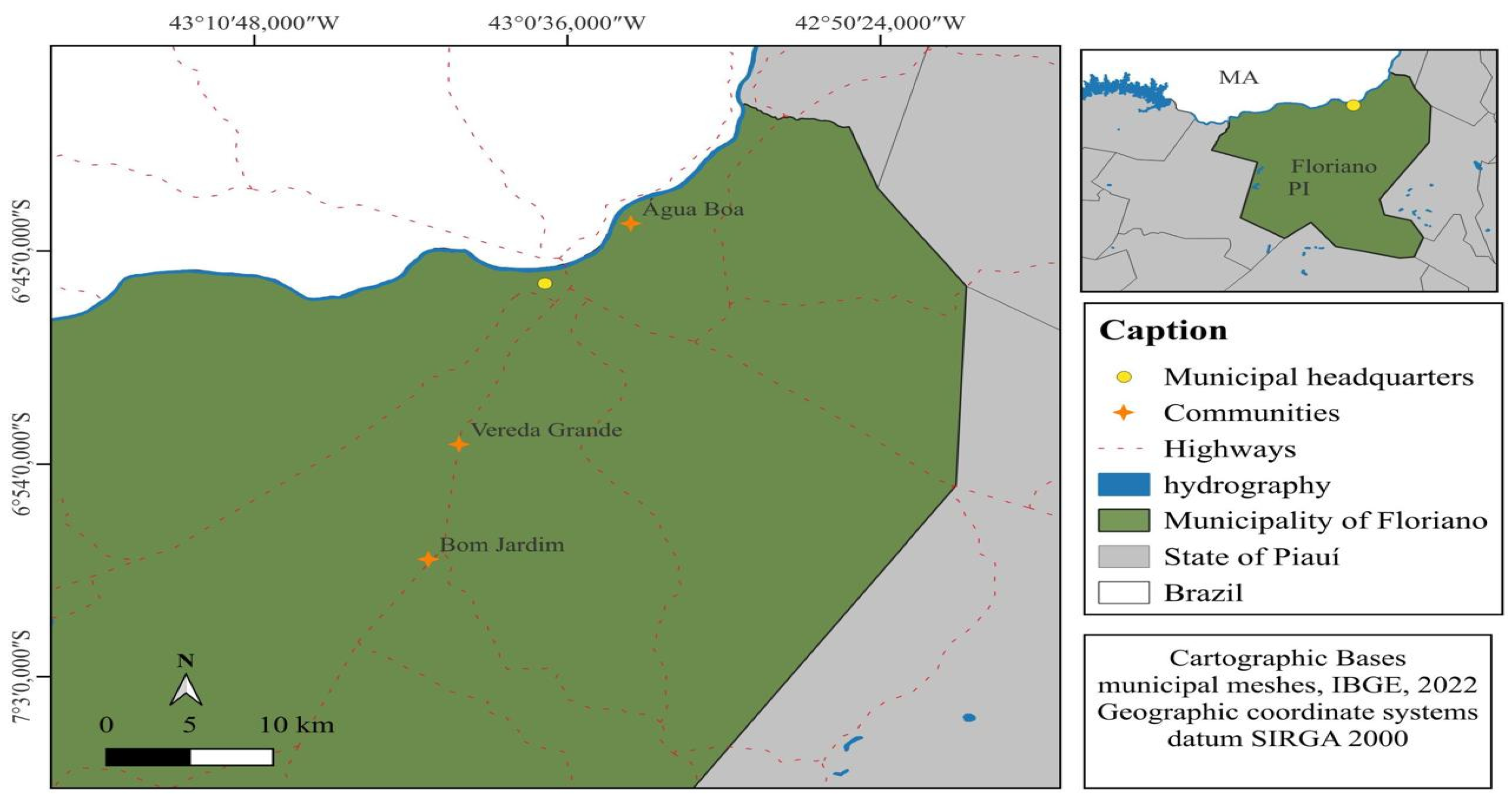
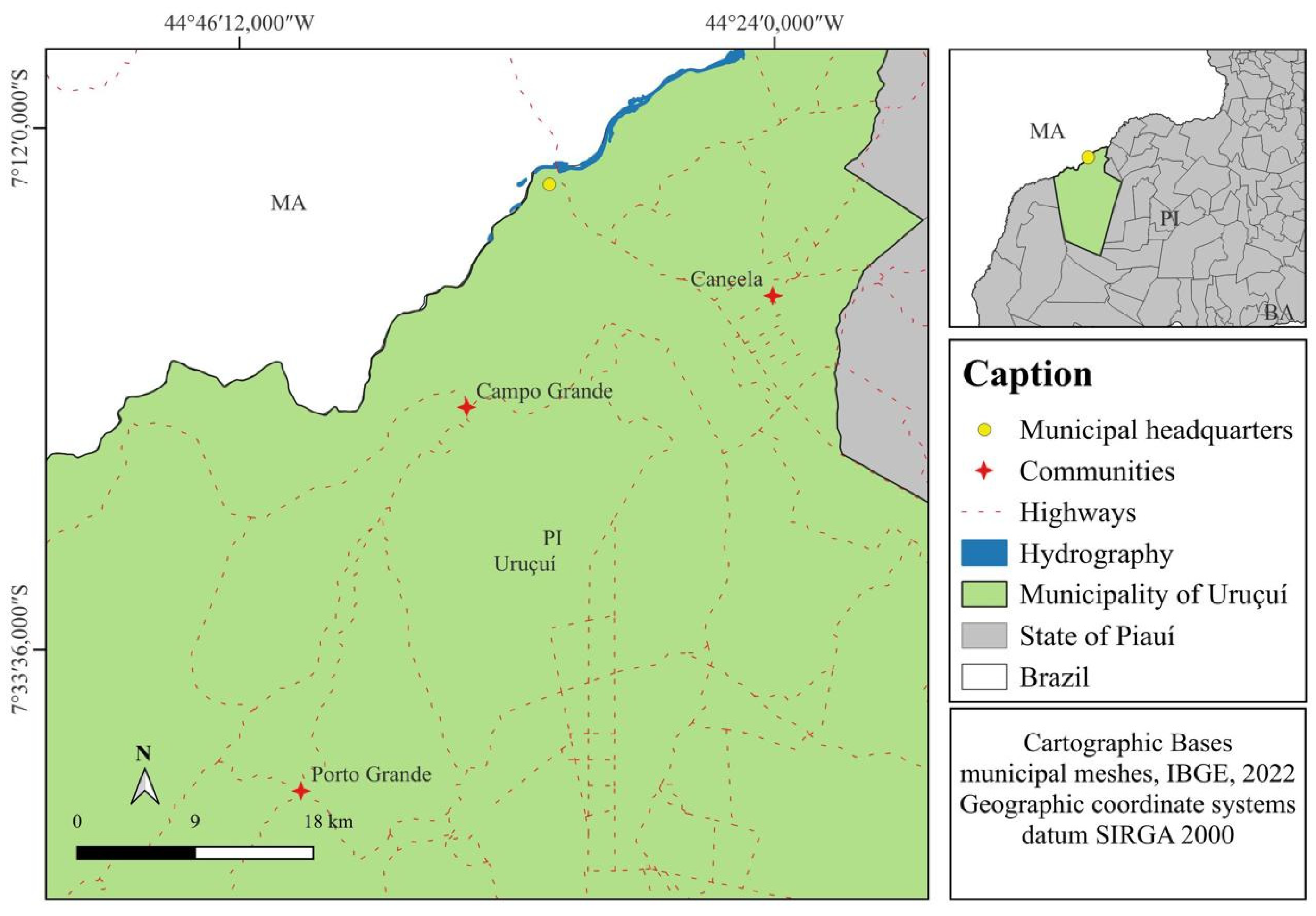

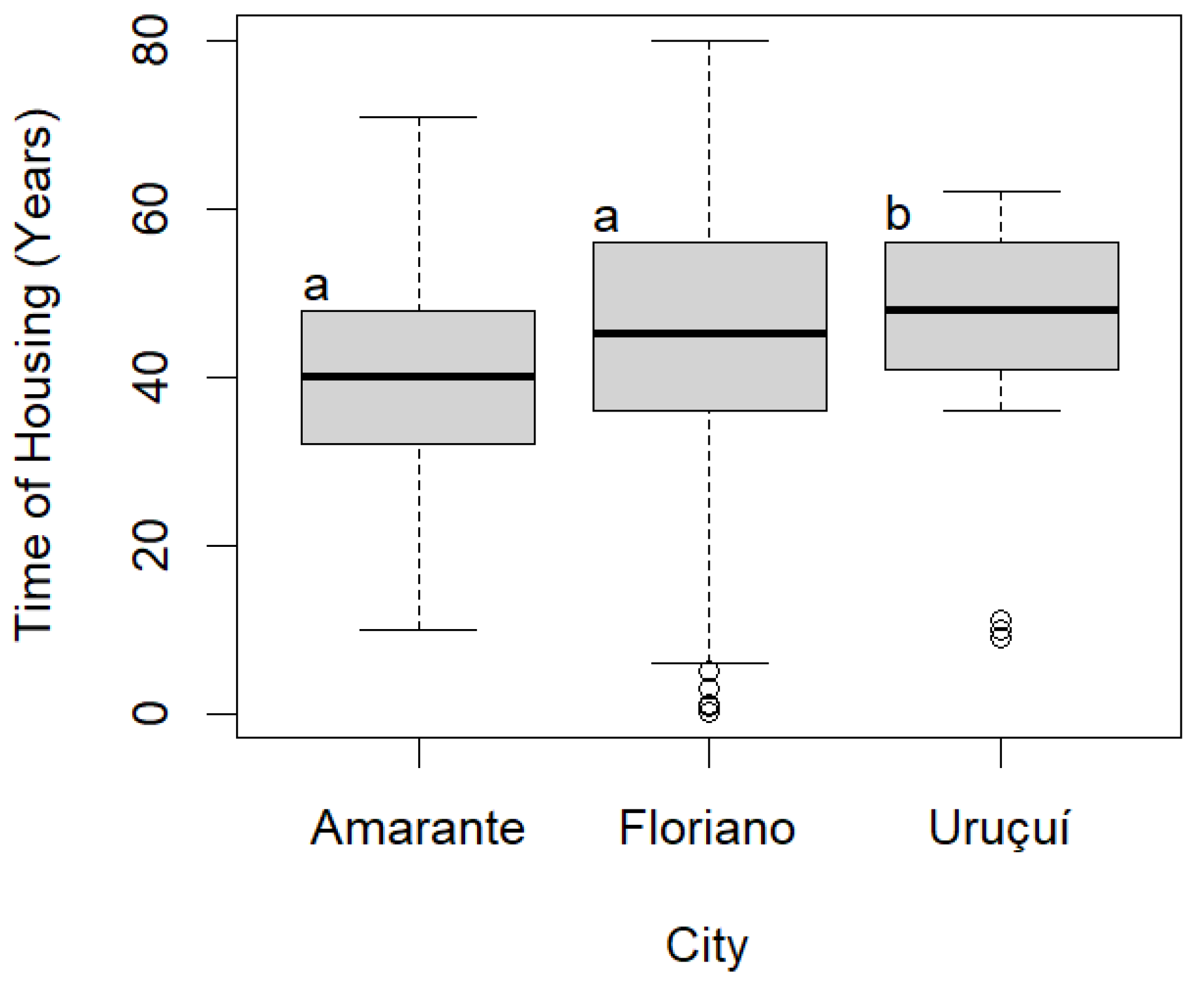
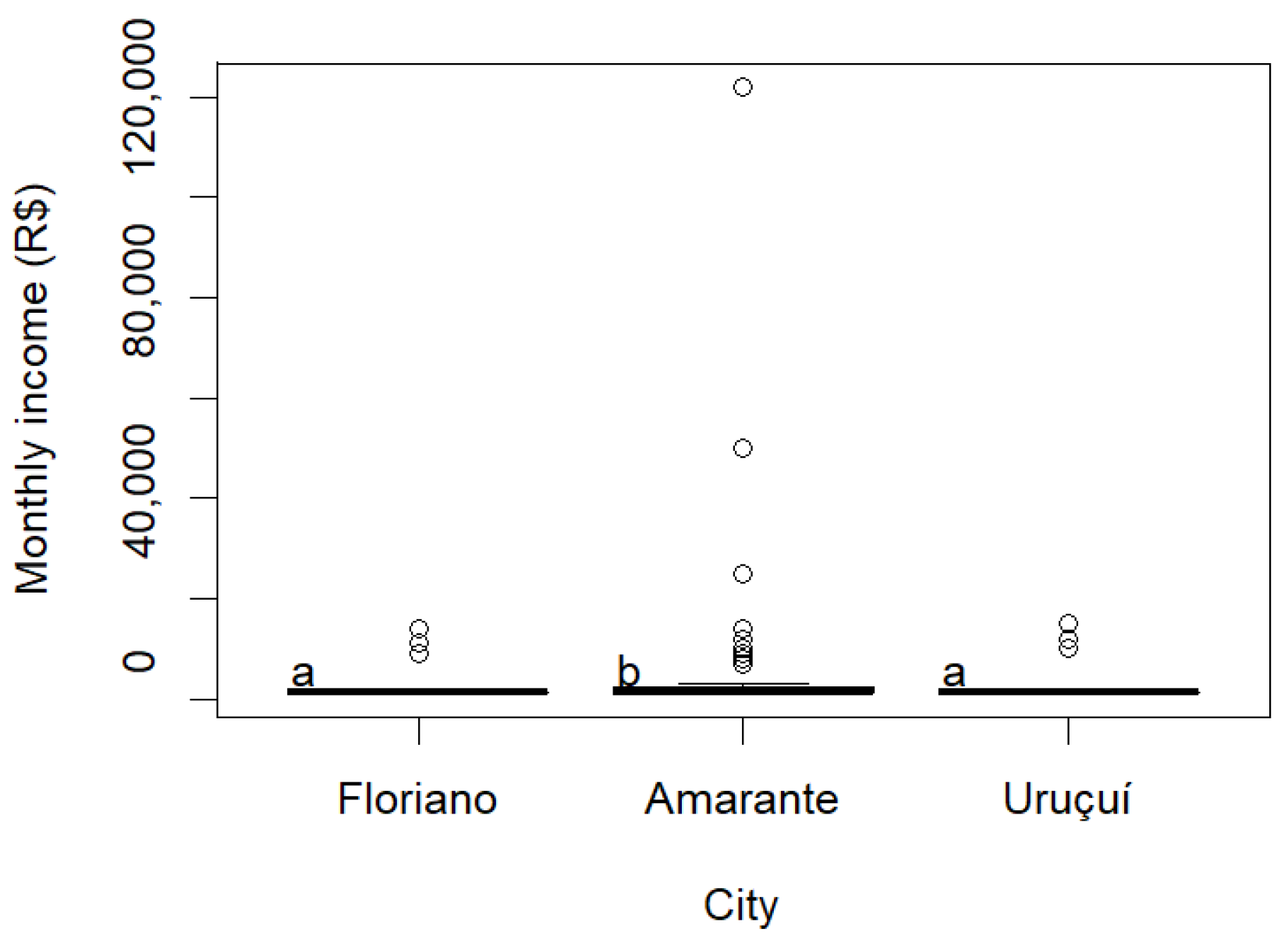

| Variables | Questions | Results | Number of Participants | Proportion (%) |
|---|---|---|---|---|
| Educational data | Level of education | Elementary School (Level 1) | 83 | 37.73 |
| Elementary School (Level 2) | 32 | 14.54 | ||
| High School | 96 | 43.63 | ||
| Technical Education | 1 | 0.45 | ||
| Higher Education | 9 | 4.09 | ||
| Demographic data | Length of residence in the community | Up to 10 years | 17 | 7.73 |
| 11 to 29 years | 9 | 4.09 | ||
| More than 30 years | 180 | 82.00 | ||
| Government assistance | Government aid | Seguro Pescador (“Fisher’s Insurance”) | 12 | 5.45 |
| Bolsa Família (“Family Allowance”) | 8 | 3.63 | ||
| Garantia Safra (“Crop Guarantee”) | 74 | 33.63 | ||
| Income source | Income Source | Agriculture | 2 | 0.9 |
| Agriculture and handicrafts | 144 | 65.45 | ||
| Agriculture and commerce | 220 | 100 | ||
| Agricultural activity | What do they plant and cultivate? | Crops: Beans, pumpkin, watermelon, melon, cassava, maxixe, okra, jerimum, banana, soy, pepper, Brazilian eggplant, tomato, corn | 10 | 4.54 |
| What is the reason for using the plantation? | Commercialization and consumption | 9 | 4.09 | |
| Commercialization | 199 | 90.45 | ||
| Consumption | 2 | 0.9 | ||
| Total number of participants | 220 |
Disclaimer/Publisher’s Note: The statements, opinions and data contained in all publications are solely those of the individual author(s) and contributor(s) and not of MDPI and/or the editor(s). MDPI and/or the editor(s) disclaim responsibility for any injury to people or property resulting from any ideas, methods, instructions or products referred to in the content. |
© 2025 by the authors. Licensee MDPI, Basel, Switzerland. This article is an open access article distributed under the terms and conditions of the Creative Commons Attribution (CC BY) license (https://creativecommons.org/licenses/by/4.0/).
Share and Cite
Costa, C.C.d.; Rodrigues, A.C.A.; Arantes, C.C.; Santos, G.G.A.d.; Ruz, E.J.H. Socioeconomic Profile of Agricultural Producers and Production Systems in Municipalities of Piauí, Brazil. Sustainability 2025, 17, 4137. https://doi.org/10.3390/su17094137
Costa CCd, Rodrigues ACA, Arantes CC, Santos GGAd, Ruz EJH. Socioeconomic Profile of Agricultural Producers and Production Systems in Municipalities of Piauí, Brazil. Sustainability. 2025; 17(9):4137. https://doi.org/10.3390/su17094137
Chicago/Turabian StyleCosta, Creusa Carvalho da, Ana Cristina Alves Rodrigues, Caroline Chaves Arantes, Graciliano Galdino Alves dos Santos, and Emil José Hernández Ruz. 2025. "Socioeconomic Profile of Agricultural Producers and Production Systems in Municipalities of Piauí, Brazil" Sustainability 17, no. 9: 4137. https://doi.org/10.3390/su17094137
APA StyleCosta, C. C. d., Rodrigues, A. C. A., Arantes, C. C., Santos, G. G. A. d., & Ruz, E. J. H. (2025). Socioeconomic Profile of Agricultural Producers and Production Systems in Municipalities of Piauí, Brazil. Sustainability, 17(9), 4137. https://doi.org/10.3390/su17094137






